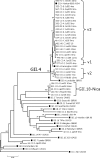Pediatric norovirus diarrhea in Nicaragua
- PMID: 18562593
- PMCID: PMC2519475
- DOI: 10.1128/JCM.00505-08
Pediatric norovirus diarrhea in Nicaragua
Abstract
Information about norovirus (NoV) infections in Central America is limited. Through a passive community and hospital pediatric diarrhea surveillance program, a total of 542 stool samples were collected between March 2005 and February 2006 in León, Nicaragua. NoV was detected in 12% (65/542) of the children; of these, 11% (45/409) were in the community and 15% (20/133) were in the hospital, with most strains (88%) belonging to genogroup II. NoV infections were age and gender associated, with children of <2 years of age (P < 0.05) and girls (P < 0.05) being most affected. Breast-feeding did not reduce the number of NoV infections. An important proportion (57%) of NoV-infected children were coinfected with diarrheagenic Escherichia coli. A significant proportion (18/31) of NoV-positive children with dehydration required intravenous rehydration. Nucleotide sequence analysis (38/65) of the N-terminal and shell region in the capsid gene revealed that at least six genotypes (GI.4, GII.2, GII.4, GII.7, GII.17, and a potentially novel cluster termed "GII.18-Nica") circulated during the study period, with GII.4 virus being predominant (26/38). The majority (20/26) of those GII.4 strains shared high nucleotide homology (99%) with the globally emerging Hunter strain. The mean viral load was approximately 15-fold higher in children infected with GII.4 virus than in those infected with other G.II viruses, with the highest viral load observed for the group of children infected with GII.4 and requiring intravenous rehydration. This study, the first of its type from a Central American country, suggests that NoV is an important etiological agent of acute diarrhea among children of <2 years of age in Nicaragua.
Figures



References
-
- Bull, R. A., M. M. Tanaka, and P. A. White. 2007. Norovirus recombination. J. Gen. Virol. 883347-3359. - PubMed
Publication types
MeSH terms
Substances
Associated data
- Actions
- Actions
- Actions
- Actions
- Actions
- Actions
- Actions
- Actions
- Actions
- Actions
- Actions
- Actions
- Actions
- Actions
- Actions
- Actions
- Actions
- Actions
- Actions
- Actions
- Actions
- Actions
- Actions
- Actions
- Actions
- Actions
- Actions
- Actions
- Actions
- Actions
- Actions
- Actions
- Actions
- Actions
LinkOut - more resources
Full Text Sources
Medical

